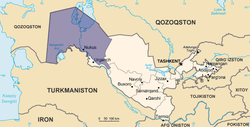Nukkus:nukus
| Nukus Uzbek: Nukus / Нукус Karakalpak: No‘kis / Нөкис | |
|---|---|
|
The Savitsky Karakalpakstan Art Museum at Nukus | |
 Nukus Location in Uzbekistan | |
| Coordinates: 42°28′N 59°36′E / 42.467°N 59.600°ECoordinates: 42°28′N 59°36′E / 42.467°N 59.600°E | |
| Country |
|
| Province | Karakalpakstan |
| Government | |
| • Type | City Administration |
| Population (2004 est.) | |
| • Total | 260,000 |
Nukus (Uzbek: Nukus / Нукус; Karakalpak: No‘kis / Нөкис; Kazakh: Нөкіс; Russian: Нукус) is the sixth-largest city in Uzbekistan, and the capital of the autonomous Karakalpakstan Republic. It has a population of 271,400 (2010 estimate). The population of Nukus on April 24th 2014 is approximately 230,006. The Amu Darya river passes west of the town.
The city is best known for its world-class Nukus Museum of Art.
History
The name Nukus is associated with the old tribal name Uzbeks - Nukus.[1] Nukus developed from a small settlement in 1932 into a large, modern Soviet city with broad avenues and big public buildings by the 1950s. The city's isolation made it host to the Red Army's Chemical Research Institute, a major research and testing center for chemical weapons.
Sights
Nukus is host to the Nukus Museum of Art (also known as the State Art Museum of the Republic of Karakalpakstan, named after Igor V. Savitsky) and State Museum. The State Museum houses the usual collection of artifacts recovered from archaeological investigations, traditional jewelry, costumes and musical instruments, but more interestingly, displays of the area's now vanished or endangered flora and fauna, and on the Aral Sea issue. The Art Museum is noted for its collection of modern Russian and Uzbek art from 1918-1935. Stalin tried his best to eliminate all non Soviet art from this period, and sent most of the artists to the gulag. Both Savitsky himself and the collection at Nukus survived because of the city's remoteness. The documentary film The Desert of Forbidden Art is all about the collection and its history.
Nukus is also home to the Progress Center, Central Asia's finest English-language institute. Housed in a former Komsomol meeting hall, the institute has received major funding from UNICEF.[3]
Climate
Nukus experiences a desert climate (Köppen BWk) with summers that are long, dry and very hot, and winters that are short, though quite cold.
| Climate data for Nukus | |||||||||||||
|---|---|---|---|---|---|---|---|---|---|---|---|---|---|
| Month | Jan | Feb | Mar | Apr | May | Jun | Jul | Aug | Sep | Oct | Nov | Dec | Year |
| Average high °C (°F) | −0.3 (31.5) |
1.9 (35.4) |
10.6 (51.1) |
21.0 (69.8) |
28.7 (83.7) |
33.8 (92.8) |
36.0 (96.8) |
33.3 (91.9) |
27.5 (81.5) |
18.1 (64.6) |
10.2 (50.4) |
2.6 (36.7) |
18.62 (65.52) |
| Average low °C (°F) | −8.8 (16.2) |
−7.9 (17.8) |
−0.8 (30.6) |
7.6 (45.7) |
13.9 (57) |
18.3 (64.9) |
20.8 (69.4) |
18.1 (64.6) |
11.8 (53.2) |
4.3 (39.7) |
−0.7 (30.7) |
−5.2 (22.6) |
5.95 (42.7) |
| Average precipitation mm (inches) | 10.1 (0.398) |
8.7 (0.343) |
16.4 (0.646) |
19.3 (0.76) |
12.2 (0.48) |
3.9 (0.154) |
3.5 (0.138) |
2.1 (0.083) |
3.0 (0.118) |
8.7 (0.343) |
9.4 (0.37) |
13.6 (0.535) |
110.9 (4.368) |
| Avg. precipitation days | 9.5 | 7.6 | 8.9 | 9.0 | 6.1 | 3.6 | 2.8 | 1.7 | 2.4 | 4.9 | 6.1 | 9.7 | 72.3 |
| Source: World Meteorological Organisation (UN) [4] | |||||||||||||
See also
References
- ↑ Словарь современных географических названий. — Екатеринбург: У-Фактория. Под общей редакцией акад. В. М. Котлякова. 2006.
- ↑ Tom Bissell, Chasing the Sea, Pantheon (2003). ISBN 0-375-42130-0. p. 323–324.
- ↑ Bissell, Chasing the Sea, p. 325–326.
- ↑ "World Weather Information Service – Nukkus". United Nations. Retrieved 5 January 2011.
External links
| Wikimedia Commons has media related to Nukus. |
| ||||||||||

